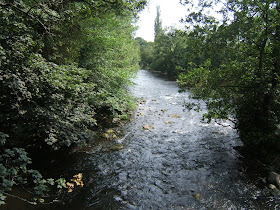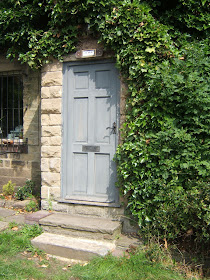One of the distinctive features of West Yorkshire is the juxtaposition of moorland with urban sprawl. This photograph was taken from a quiet moorland, populated mainly by birds and the odd dog walker, but looks out over the busy city of Bradford.
Bradford began as a village in Saxon times, it's name meaning Broad Ford since it grew around the confluence of three brooks. It is recorded in the Domesday book of 1086 as having a population of around 300 - 350 people. Today, it is slightly larger, being in the region of 467,000.
A number of factors contributed to Bradford's growth into a significant urban area. It became a town when it was granted permission to hold a market and, in 1461, was allowed to hold two annual fairs, to which buyers and sellers from all over Yorkshire would travel. The local woollen industry continued to grow and by the sixteenth century, the town was servicing a significant number of cottage weavers. There was also a tanning industry in the town.
The town had a difficult time around the English Civil war, being a Parliamentarian stronghold in the midst of a sea of Royalist support. It was attacked on a number of occasions and eventually sacked by the Royalists. When it was abandoned by them in 1644, the Parliamentarians moved back in, but within a year, Bradford was hit by her second bout of the plague.
It was not until the late seventeenth century that Bradford once again became prosperous when the local textile industry began to combine wool with cotton to make worsted cloth. This put the town in the ideal position to take advantage of the Industrial Revolution. By 1841, there were 38 worsted mills in the town and 70 in the borough (including Lister Mill to the right of the photograph below). Bradford was the wool capital of the world and, by 1851, the population had grown to 103,000, many of whom lived in appalling conditions.The infrastructure of the city began to take shape with gas lit streets, drains and sewers and piped water. An infirmary was built in 1843 and Peel Park opened in 1863. In 1846, the railway reached the city and by 1898, electric trams ran through the streets.
The textile industry continued to be important in Bradford until it's decline after the second world war. For a while, it's place was taken by the manufacture of tractors and televisions, but recession and mass unemployment hit in the 1980s. The economy diversified and survived through engineering, printing, packaging and chemical industries. Tourism was also something of a lifeline, with a number of museums being opened reflecting the history of the city.
When I mention Bradford to friends who live away from the city, I get a mixed reaction. It is known as a strongly multicultural city with significant populations of Bangladeshis, Pakistanis, Indians and Afro-Carrribeans. In itself, this is not a problem, but the riots of 1995 and 2001 still remain in memories. On the other hand, some of my friends have visited the National Media Museum and speak highly of their visits to the city, saying it is a very friendly place.
For an outsider, the truth is always difficult to perceive, but I remember teaching a lad in London. He moved down from Bradford and into my class very soon after the beginning of the year, but his family didn't stay long. One morning, after about six months, he came into the classroom and announced that he was leaving. When I asked him why his reply was very clear "My dad says we can go back Miss. It's much better in Bradford than it is down here."



















































